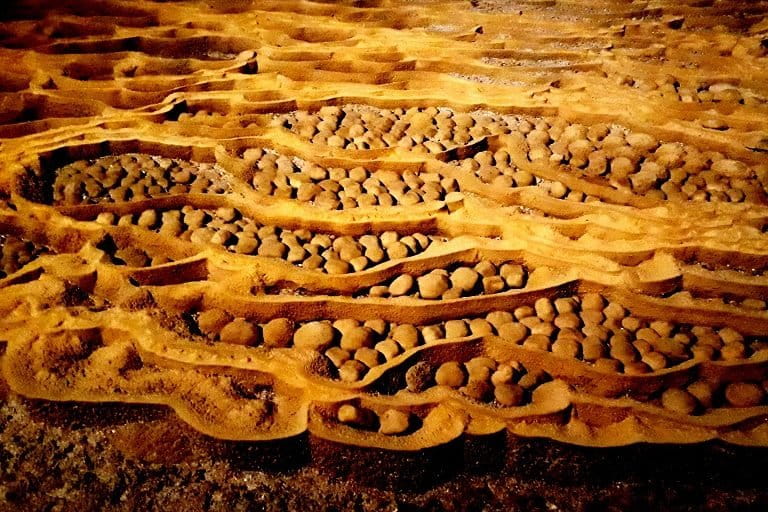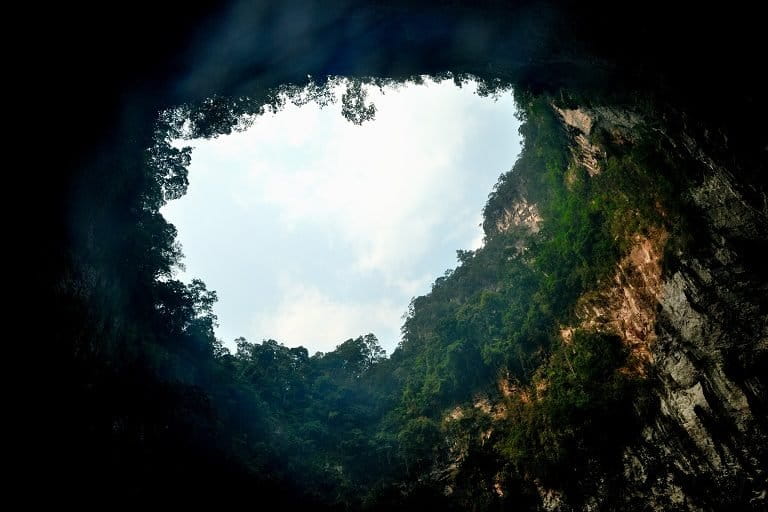- Once construction is finished, the cable car could carry thousands of tourists to Son Doong cave every day.
- Currently, fewer than 800 people visit the caves every year through sustainable eco-tourism company Oxalis.
- There is also growing concern that a cable car could irreparably damage the area’s primary forests.
- An online petition that’s part of the campaign against the development has garnered about 170,000 signatures.
PHONG NHA, Vietnam – Since 2014, one of the world’s largest cave systems has been under threat from developers planning to construct a cable car that would carry thousands of tourists every day.
Some are pointing out that this could also irreparably damage the area’s primary forests. A movement to stop the cable car reaching the area known as Son Doong cave spearheaded by Vietnamese environmentalist Huong Le has gained traction over the last 3.5 years. Huong has been involved in efforts to garner what is now up to over 170,000 signatures on a petition against the proposed development.
The caves in question, which feature some of the world’s largest stalactites and cave pearls, are truly remarkable. Located in a UNESCO’s World Heritage site called Phong Nha-Ke Bang National Park, Son Doong cave is so large it contains a fast-flowing, subterranean river, two jungles, a beach that visitors can camp on overnight, and seven endemic species that don’t exist anywhere else in the world. It has the largest cross section of any cave – twice that of its nearest rival – and is tall enough to fit in a 40-story building.

Currently, a sustainable eco-tour brings fewer than 800 people to Son Doong annually. In comparison, the proposed cable car would bring about 1,000 people every hour, a shift that would threaten the pristine ecosystems within the cave.
Many also fear the construction needed for the cable cars would damage forest near the entrance and put pressure on the cave’s fragile roof, potentially triggering further dolines, which is when the roof of the caves collapses due to limestone erosion.

Vietnamese real estate company Sun Group initially proposed construction of a cable car in 2014, but scrapped the plans entirely, Huong believes, due to public support for the petition. In the summer of 2017, Vietnamese Prime Minister Nguyen Xuan Phuc approved a new plan to build a cable car into nearby En Cave (the world’s third largest), this time headed by Vietnamese real estate giants FLC Group. Since then, the company has kept quiet about their plans for the project.
Efforts to stop the cable car, however, have been gathering pace. And in a nation where, historically, the Communist Party of Vietnam has not supported organized expression of collective identity, social media has, to an extent, provided a platform for civil society movements to form.
Huong Le’s Save Son Doong Facebook page, for example, has gained hundreds of thousands of followers. It propelled her to a speaker’s spot at a TEDx event in Hanoi this past June.
Her brave, spirited speech, which covered not only the caves, but also the issue of political transparency in Vietnam, drew tears, wild applause, and a standing ovation from the audience.

Huong works full-time at Saigon’s Fulbright University as an admissions officer and dedicates her free time to the Save Son Doong campaign. Her efforts earned her a place on Forbes Vietnam’s 30 under 30 list earlier this year, a scholarship to study in the US and even a chance to speak to Barack Obama during his state visit to Vietnam in 2016. Obama later declared in his address to the nation that Son Doong Cave should be preserved for future generations.
The core message of Huong’s TEDx speech was the importance of protecting the fragile ecosystems within the cave. Between 2 and 4 million years old, the caves have been untouched by human hands for millennia and, as a result, pristine ecosystems have thrived within.
With two dolines already puncturing the roof, light has been able to enter, creating some of the largest areas of intact primary forest anywhere in Vietnam and an impressively high level of biodiversity: over 800 vertebrate species have been recorded in the area, including 154 mammals, 117 reptiles, 58 amphibians, 314 birds, and 170 fish.

Phuong Tạ, head of Hanoi University’s ecology department and the first scientist allowed to explore and study the caves, has been instrumental in inspiring and informing Huong. “Each cave is a separate world, an individual ecosystem,” Phuong said. “Each one has a different temperature, humidity and air quality. All of this creates an ecosystem in which only a few animals can adapt and survive.”
Phuong stresses that there are unique creatures in the cave such as arthropods, blind fish, rare myriapoda centipedes and white translucent shrimp that can only thrive in an environment that’s disconnected from the outside world. He also found cave pearls the size of baseballs, which is unheard of anywhere else in the world, along with rimstones, tetra coral fossils and 70m (230 feet) stalagmites. But if more light, noise, or even “human breath” finds its way inside, he says, the ecosystem could be “severely affected.”
When the cable car plans shifted to En Cave, Phuong drafted a letter to Vietnamese Prime Minister Nguyen Xuan Phuc asserting the right of local people to resist the cable car. According to the letter, which Mongabay gained access to, “Even if they get to En Cave it’s in the centre of Phong Nha-Ke Bang National Park, and the tropical forest ecosystem there should be protected. If the cable car gets there the forest will definitely be ruined.” The Vietnamese government responded noting receipt of the letter, but made no further contact.

Despite the lack of response, efforts like Phuong’s may be the only way to save the caves. When Huong first explored Son Doong Cave, she met British Cave Expert Howard Limbert, the man who dedicated 18 years of his life to discovering the cave, and he explained the importance of Vietnamese intervention.
During the trek, Limbert spoke to Huong at length. “I was the only Vietnamese in the group. He shared with me the news about the cable car, and that was the very first time I heard of it. That was July 2014. I think what moved me the most was that he said he regretted discovering this place.” Huong noted in her TEDx talk that Limbert broke down in tears as he spoke of his regret.
“Obviously this cave means a lot to this man,” she said. “He dedicated so much of his life to discovering it, and then he felt hopeless. But he carried on saying we still have hope, but the people who can actually make changes must be Vietnamese people. As a foreigner, he can only provide advice, not actually advocate for changes.”

It was this talk that lit a fire in Huong, and she hasn’t ceased campaigning since. Limbert, meanwhile, has found himself at the vanguard of eco-tourism in Vietnam. Oxalis, the adventure tour company he works for, now employs 550 people from Quang Binh Province, some of whom used to be involved in illegal logging and hunting in the area.
For Limbert, the connection between employment and conservation couldn’t be clearer. By providing jobs to locals, he says, the temptation to get involved in illegal, environmentally damaging activities is taken away. “There’s no hunting now,” he said, “there’s no logging of rare woods. We’re seeing far more animals appearing in the area where we run tours.”

Every action has a consequence, however, and Phuong notes that, even with small, eco-friendly tours, there is evidence of environmental wear and tear in the caves. “Five years ago I visited Son Doong for the first time,” he said. “Recently, I went in again, and I saw that the system of cave pearls has faded, its quality worsened and become drier.” If more people come in, he says, this deterioration would continue, although he is yet to complete his latest round of scientific analysis.
For Huong Le, the need to campaign and protect the caves and the forests within them remains as urgent as ever. Rampant development continues to blight Vietnamese landscapes; this year, an enormous casino will open on Phu Quoc Island, while the pollution of Ha Long Bay demonstrates what happens when nature is sacrificed for tourism. Nobody wants Son Doong to be the next regret.
“The more signatures we have [on our petition], the more likes on Facebook, it helps send a message directly to the cable car company,” she said. “It used to be Sun Group, and the reason they pulled out of the project is because of our followers. The easy thing people in Vietnam and around the world can do right away would be to sign the petition and follow us on Facebook. Talk about it, share it, and raise your voice.”
Banner image: A butterfly in the forest outside Son Doong Cave (Courtesty Professor Phuong Ta).
FEEDBACK: Use this form to send a message to the author of this post. If you want to post a public comment, you can do that at the bottom of the page.

